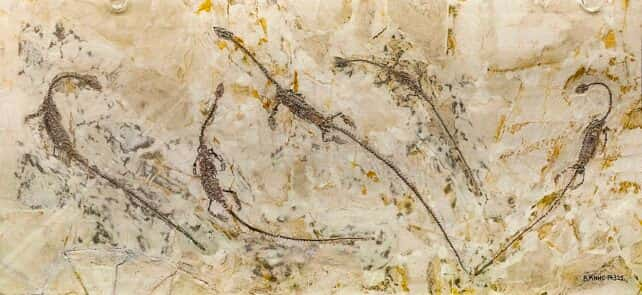A fossil unearthed two decades ago in northeastern China has captured renewed scientific attention this summer after researchers confirmed it as the oldest known case of polycephaly—a congenital condition where an animal is born with more than one head. Published in the journal Biology Letters by the Royal Society in 2006, and recently revisited in several scientific outlets, the fossil showcases a rare prehistoric deformity that offers striking insights into the evolutionary biology of vertebrates.
At first glance, the fossil appears to show a familiar long-necked reptile, a juvenile measuring just under 3 inches. But on closer inspection, its spinal column divides into two necks, each supporting a fully developed skull. The creature, known as Hyphalosaurus lingyuanensis, is a member of the choristoderes, a now-extinct group of semi-aquatic reptiles that swam through freshwater lakes during the Early Cretaceous period, around 120 million years ago.
A Tale of Two Skulls Preserved for 120 Million Years
Discovered in the fossil-rich Yixian Formation, the juvenile Hyphalosaurus fossil was first notable for its delicate preservation. Researchers quickly identified its extraordinary feature: a bifurcated spinal column leading to two distinct necks and skulls—an extremely rare condition in both extinct and modern animals.
According to the Biology Letters article authored by paleontologist Éric Buffetaut and colleagues, the fossil is preserved on an unbroken slab of stone, with subtle sediment layers still covering parts of the skeleton. There is no evidence of tampering, leading scientists to conclude the fossil’s deformity was genuine and naturally occurring.


Modern reptiles occasionally display similar deformities—two-headed snakes and turtles, for instance—but such cases are rarely compatible with long-term survival. This fossilized example may not have survived long either. Its small size and incomplete bone development suggest the creature likely died shortly after birth, or perhaps even before fully hatching.
Meet Hyphalosaurus, the Overlooked Aquatic Reptile
Often confused with dinosaurs due to its ancient origin, Hyphalosaurus was anything but. This little-known genus thrived during the Cretaceous period in what are now Chinese lake beds. Its slender body, elongated neck, and paddle-like limbs made it well-suited to an aquatic lifestyle, similar in some respects to modern-day newts or small marine reptiles.
While most fossil discoveries from the Yixian Formation have focused on feathered dinosaurs and primitive birds, this particular specimen stood out not for its species, but for the genetic anomaly it preserved in stone. As such, it serves as a rare example of how the same biological glitches that affect modern animals also occurred in deep time.


Paleontologists say that discovering such a precise snapshot of a developmental disorder in an extinct species is nothing short of extraordinary. The odds of fossilizing a malformed embryo or newborn are vanishingly small, making this fossil a scientific jackpot.
Unlocking Secrets of Ancient Development Disorders
The two-headed Hyphalosaurus is not only a curiosity but a data point in a long-running investigation into how developmental processes have evolved across geologic time. The condition observed—axial bifurcation—is thought to result from a failed embryonic twinning process, where a single embryo begins to split but does not complete the separation, resulting in two heads on one body.
This anomaly remains rare in modern vertebrates, yet it has been well documented in reptiles. What makes the Hyphalosaurus find so groundbreaking is that it pushes the timeline of such occurrences back by more than 100 million years.
According to researchers, this suggests that the mechanisms leading to polycephaly have existed in vertebrate lineages far longer than previously confirmed. The fossil becomes not just a record of one malformed animal, but evidence of a deep evolutionary continuity in how vertebrate bodies can develop—and misdevelop.
Source link


